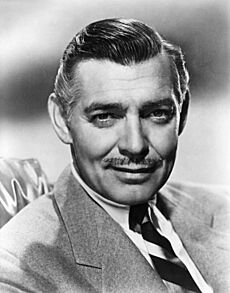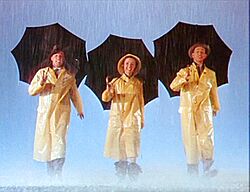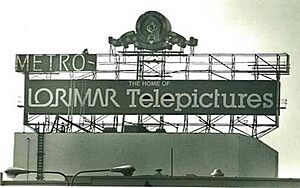Metro-Goldwyn-Mayer facts for kids
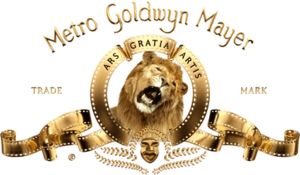
Logo used since 2021, featuring Leo the Lion
|
|
|
Trade name
|
Metro-Goldwyn-Mayer |
|---|---|
|
Formerly
|
|
| Subsidiary | |
| Industry | |
| Predecessors |
|
| Founded | April 17, 1924 |
| Founders |
|
| Headquarters |
,
United States
|
|
Number of locations
|
4 |
|
Area served
|
Worldwide |
|
Key people
|
Jennifer Salke (CEO) Mark Burnett (chairman, MGM Television) |
| Products |
|
|
Number of employees
|
4,200 (2022) |
| Parent |
|
| Divisions |
|
Metro-Goldwyn-Mayer Studios Inc. (often called MGM) is a famous American company that makes and distributes movies and TV shows. Its main office is in Culver City, California. MGM started on April 17, 1924. Since 2022, it has been owned by Amazon, as part of its Amazon MGM Studios group.
MGM was created by Marcus Loew. He brought together three smaller companies: Metro Pictures, Goldwyn Pictures, and Louis B. Mayer Pictures. MGM became known for having many famous actors, with its slogan "more stars than there are in heaven." It quickly became one of Hollywood's most important film companies. MGM made many popular musicals and won lots of Academy Awards.
The company also owned film studios, movie lots, and theaters. Its most successful time was from 1926 to 1959. During this period, it made two versions of the epic film Ben Hur. MGM later sold its movie theater chain and started making TV shows in 1956.
In 1969, a businessman named Kirk Kerkorian bought a large part of MGM. He changed how the studio worked, making fewer films each year. He also started other businesses, like MGM Resorts International, a hotel and casino company in Las Vegas. In 1980, the original MGM company separated its film and TV studio to focus on hotels. The film studio was renamed Metro-Goldwyn-Mayer Film Co. The next year, it bought United Artists (UA).
In 1986, Kerkorian sold MGM to Ted Turner. Turner kept the rights to MGM's film library. He sold the studio lot in Culver City and then sold the rest of MGM back to Kerkorian a few months later. Kerkorian bought and sold the company again in the 1990s. He made MGM bigger by buying Orion Pictures and the Samuel Goldwyn Company, which added their film libraries to MGM's collection. In 2005, Kerkorian sold MGM to a group of companies, including Sony Pictures.
MGM was listed on the New York Stock Exchange until 1986. It was listed again in 1997.
In 2010, MGM faced serious financial trouble and had to reorganize. It came out of this situation later that year, owned by its creditors. Two former executives, Gary Barber and Roger Birnbaum, became leaders of MGM's new holding company. After Barber left in 2018, the studio looked for another company to buy it. In May 2021, Amazon bought MGM for $8.45 billion. The deal was completed in March 2022. In October 2023, Amazon Studios became Amazon MGM Studios, taking over MGM Holdings.
As of 2023, MGM's most successful movie series include James Bond and Rocky. Its recent TV shows include Fargo and The Handmaid's Tale. MGM is a member of the Motion Picture Association (MPA).
Contents
- About MGM Studios
- MGM's Story
- How MGM Started
- The 1920s and 1930s: A Golden Age
- The 1940s: Musicals and Changes
- The 1950s: New Challenges
- MGM Enters Television
- MGM Cartoons
- MGM in the 1960s
- Kirk Kerkorian's Influence
- MGM/UA Entertainment
- MGM Entertainment and Turner's Purchase
- MGM/UA Communications and New Owners
- MGM-Pathé Communications and Financial Troubles
- Metro-Goldwyn-Mayer Pictures Returns
- MGM Holdings and New Ownership
- Amazon Takes Over
- MGM Headquarters
- Leo Logo and Mottos
- MGM's Film Library
- Film Distribution
- Other International Deals
- See also
About MGM Studios
MGM was one of the last studios to start making movies with sound. However, from the end of the silent movie era until the late 1950s, it was the most powerful movie studio in Hollywood. MGM was slow to change with the times in the 1950s and 1960s. Even though its movies often made money, the company lost a lot of money throughout the 1960s.
In 1966, MGM was sold to a Canadian investor, Edgar Bronfman Sr.. Three years later, Kirk Kerkorian bought MGM, which was losing money. He cut staff and reduced movie production. He also stopped distributing movies to theaters in 1973. The studio continued to make a few films each year, which were distributed by other studios, usually United Artists (UA). When Kerkorian bought UA in 1981, he promised to make more movies and expand the film library.
MGM started making more of its own movies and UA continued to do well, especially with the popular James Bond movies. However, the studio took on a lot of debt to make more films. MGM got even more debt as different owners took charge in the 1980s and early 1990s. In 1986, Ted Turner bought MGM, but a few months later, he sold the company back to Kerkorian to pay off huge debts. Turner kept the film library for himself. These deals left MGM with even more debt.
In 1990, Giancarlo Parretti bought MGM. But Parretti lost control, and the French bank Crédit Lyonnais, which had loaned money for the purchase, took over MGM in 1992. Still deep in debt, MGM was bought by a group including Kerkorian in 1996.
All this debt made it hard for MGM to stay an independent movie studio. After a bidding war, MGM was bought on September 23, 2004, by a group of companies including Sony Corporation of America and Comcast.
After its financial reorganization in 2010, MGM's creditors took ownership of the company. New leaders were put in charge of its film and TV production.
MGM's Story
How MGM Started
In 1924, Marcus Loew, who owned many movie theaters, had a problem. He had bought Metro Pictures Corporation in 1919 to get a steady supply of films for his theaters. But the movies were not very good. To fix this, Loew bought Goldwyn Pictures in 1924 to get better quality films. He got the Goldwyn studio, its famous Leo the Lion logo, and its stars.
However, Loew needed someone to manage his new Hollywood operations. He found Louis B. Mayer, who ran Louis B. Mayer Pictures. Loew bought Mayer's studio. On April 17, 1924, the three studios merged, forming Metro-Goldwyn-Mayer. Mayer became the head of MGM, with 24-year-old Irving Thalberg in charge of making movies.
MGM made over 100 feature films in its first two years. In 1925, MGM released the big and successful movie Ben-Hur, making a large profit.
Marcus Loew passed away in 1927. Control of Loew's went to Nicholas Schenck. In 1929, William Fox of Fox Film Corporation tried to buy Loew's, but the deal fell apart due to legal issues and the stock market crash.
The 1920s and 1930s: A Golden Age
From the beginning, MGM focused on making glamorous and sophisticated movies. Mayer and Thalberg created many new stars, like Joan Crawford, Greta Garbo, and Clark Gable. They also hired top directors. When "talkies" (movies with sound) arrived in 1928–29, MGM slowly moved into the sound era. Their first full talkie, the musical The Broadway Melody (1929), was a big hit and won the Academy Award for Best Picture.
MGM was one of the first studios to try filming in Technicolor. They used a two-color process for parts of movies like Ben-Hur (1925). In 1928, MGM released The Viking, the first full Technicolor movie with music and sound effects, but no talking. Their first all-color, all-talking movie was The Rogue Song in 1930.
MGM also distributed short films from Hal Roach Studios, including comedies with Laurel and Hardy and Our Gang. In 1938, MGM bought the rights to the Our Gang series and continued making them until 1944.
During the 1930s, MGM made about 50 movies a year. The studio was known for its grand productions that appealed to city audiences. Even during the Great Depression, MGM saved money by reusing sets and costumes. MGM was the only major Hollywood studio that always made a profit during the 1930s.
MGM stars were very popular in the 1930s. The studio was famous for creating the "stable-of-stars" system, where many actors were under contract to one studio. Stars like Joan Crawford, Greta Garbo, and Clark Gable were among the highest-paid actors at the studio.
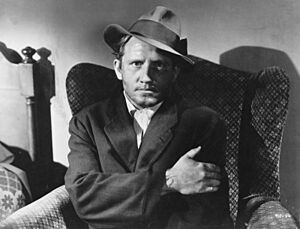
Louis B. Mayer and Irving Thalberg had some disagreements. Thalberg preferred serious literary films, while Mayer wanted more family-friendly movies. Thalberg, who was often sick, was removed as head of production in 1932. Thalberg's early death in 1936 was a big loss for MGM.
After Thalberg's death, Mayer became head of both production and the studio. He was the first executive in American history to earn a million dollars. MGM continued to be successful with popular movie series like Andy Hardy starring Mickey Rooney and The Thin Man.
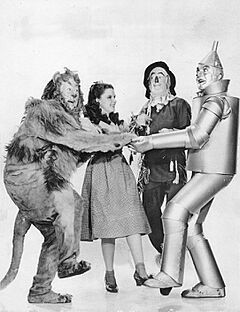
In 1937, Mayer hired Mervyn LeRoy as MGM's top producer. LeRoy convinced Mayer to buy the rights to the popular children's book The Wonderful Wizard of Oz. MGM bought the rights for $75,000 in 1938.
MGM's big hits in 1939 included The Wizard of Oz, Ninotchka with Greta Garbo, and The Women. Gone with the Wind was also a huge success. Although Gone With the Wind was made by another company, MGM distributed it as part of a deal to get Clark Gable to star in it. MGM later gained full rights to Gone With the Wind. While The Wizard of Oz was loved by critics, it took 20 years to make a profit because of its high production costs.
The 1940s: Musicals and Changes
Starting in 1942, Mayer let go of five of his highest-paid actresses, including Joan Crawford and Greta Garbo. Joan Crawford later found new success at another studio. Garbo and Norma Shearer never made another film after leaving MGM.
During World War II, MGM's management style changed, and the studio started making fewer new stars. They relied on sequels and safe, familiar stories. Production values remained high, even for "B movies," which were still expensive to make. After 1940, MGM cut its production from 50 to 25 films a year. During this time, MGM released many successful musicals with stars like Fred Astaire, Judy Garland, Gene Kelly, and Frank Sinatra.
The 1950s: New Challenges
In the late 1940s, people started watching more television, making it harder for movie studios to attract audiences to theaters. MGM's profits began to drop. The company's leaders wanted someone to improve film quality while cutting costs. Mayer thought Dore Schary, a writer and producer, could help. Schary focused on grand musicals, and hits like Easter Parade (1948) and The Great Caruso (1951) helped MGM stay profitable.
In August 1951, Louis B. Mayer was fired and replaced by Schary. Schary cut costs by letting go of expensive actors and reusing old sets and costumes. MGM's musicals, led by producer Arthur Freed, continued to be a bright spot. During the 1950s, MGM made classic musicals like An American in Paris (1951), Singin' in the Rain (1952), and Seven Brides for Seven Brothers (1954). However, some other musicals lost money.
In 1952, due to a government ruling, Loews, Inc. gave up control of MGM. By 1957, MGM lost money for the first time in its history. Most of MGM's contract actors had left by 1960.
In 1958, MGM released Gigi, which is considered its last great musical. It was a big success, winning nine Academy Awards, including Best Picture. It also had several hit songs.
MGM Enters Television
MGM's first TV show, The MGM Parade, started in 1955. It was a show that promoted MGM's movies, similar to Disney's Disneyland. Parade was canceled in 1956. MGM then decided to enter the television market itself. MGM Television was created in June 1956 to distribute films to TV and produce new shows.
In 1957, MGM closed its animation department. The studio realized it could make enough money by re-releasing old cartoons instead of making new ones. William Hanna and Joseph Barbera, who led MGM's cartoon studio, left to start their own successful company, Hanna-Barbera Productions.
In 1956, MGM sold the TV rights for The Wizard of Oz to CBS. The film was shown in November 1956, becoming the first American movie to be shown completely in one evening on a major TV network. From 1959 until 1991, The Wizard of Oz was shown every year on TV, attracting huge audiences and earning more money for MGM. Today, The Wizard of Oz is often shown on channels owned by Ted Turner.
MGM Cartoons
In 1930, MGM started distributing cartoons starring Flip the Frog, made by Ub Iwerks. In 1934, MGM hired Hugh Harman and Rudolph Ising to make a new series of color cartoons called Happy Harmonies. These cartoons often went over budget, so MGM started its own animation studio in 1937.
In 1939, MGM rehired Harman and Ising, and Ising created Barney Bear. However, MGM's most famous cartoon characters were the cat-and-mouse duo Tom and Jerry, created by William Hanna and Joseph Barbera in 1940. The Tom and Jerry cartoons won seven Academy Awards between 1943 and 1953. In 1941, Tex Avery joined the animation department and created popular cartoons like Red Hot Riding Hood and the Droopy series.
Avery left in 1953, and Hanna and Barbera focused on Tom and Jerry and Droopy. MGM closed its cartoon division in 1957.
In 1961, MGM started making new Tom and Jerry shorts again, with production moving to Prague. In 1963, Tom and Jerry production returned to Hollywood under Chuck Jones. Jones's team also made other works, including the classic TV version of Dr. Seuss's How the Grinch Stole Christmas! (1966). The Tom and Jerry shorts ended in 1967.
MGM in the 1960s
In 1959, MGM had a huge financial success with its nearly four-hour epic film Ben–Hur. This movie was a remake of its 1925 silent film. Starring Charlton Heston, it won 11 Academy Awards, including Best Picture. This record stood until Titanic in 1997 and The Lord of the Rings: The Return of the King in 2003.
During this time, MGM started a risky practice: relying on one big-budget epic film each year to make money. While Ben–Hur was very profitable, four similar big-budget remakes that followed did not do well. These losses led to changes in leadership.
New leaders seemed to help the studio for a while. MGM released David Lean's very popular Doctor Zhivago (1965), followed by hits like The Dirty Dozen (1967) and 2001: A Space Odyssey (1968). However, the company faced challenges from other companies trying to take control. MGM then had more box office failures.
In the mid-1960s, MGM started investing in real estate. Edgar Bronfman Sr. bought a controlling share of MGM in 1966.
Kirk Kerkorian's Influence
In 1969, Kirk Kerkorian bought 40% of MGM's stock. He was interested in MGM's assets, like its businesses, real estate, and the famous name. He used the MGM name for a hotel and casino in Las Vegas. The film-making part of the company was losing money, so it was made much smaller. MGM sold off its props, furnishings, and historical items, including a pair of Dorothy's ruby slippers from The Wizard of Oz. A large part of the studio's backlot was sold for real estate.
Through the 1970s, the studio made far fewer movies. In October 1973, MGM closed its own distribution offices and hired United Artists (UA) to distribute its films for ten years.
Kerkorian focused on the MGM Grand Hotel. The last filming done on the studio's backlot was for That's Entertainment! (1974), a documentary about MGM's history, which became a surprise hit.
Under Dan Melnick, who became head of production in 1972, MGM made several successful films in the 1970s, including Westworld (1973), Soylent Green (1973), and Network (1976). Despite these successes, MGM never fully regained its earlier status.
In 1979, Kerkorian announced that MGM was now mainly a hotel company. In 1980, MGM separated its film production and casino businesses into two different companies. The film company was renamed Metro-Goldwyn-Mayer Film Co.
MGM/UA Entertainment
MGM started distributing its own movies again in 1981 when it bought United Artists (UA). UA's parent company wanted to sell the studio after the huge financial failure of Heaven's Gate (1980). After this purchase, Metro-Goldwyn-Mayer Film Co. was renamed "MGM/UA Entertainment Company." MGM/UA created new divisions for home video and TV.
After the purchase of UA, MGM/UA made some unsuccessful films. Only Poltergeist (1982), WarGames (1983), and Octopussy (1983) were clear hits. Even MGM's large library of films was not enough to keep the studio financially strong.
MGM Entertainment and Turner's Purchase
On August 7, 1985, Turner Broadcasting System offered to buy MGM/UA. Ted Turner wanted MGM's film library for his TV channel WTBS. On March 25, 1986, the deal was completed for $1.5 billion. The company was renamed "MGM Entertainment Co." Turner immediately sold MGM's UA subsidiary back to Kerkorian for about $480 million. However, Turner could not get enough money to pay for the rest of the deal. So, on August 26, 1986, Turner had to sell MGM's production and distribution parts back to UA for $300 million.
Turner kept the rights to MGM films made before May 1986, along with other film libraries he had acquired. Turner used these films to start his new cable channel, Turner Network Television (TNT).
MGM/UA Communications and New Owners
After Kerkorian got MGM back in August 1986, the company changed its name to MGM/UA Communications Co. In 1987, MGM/UA Communications Co., Paramount Pictures, and Universal Pictures worked together to sell films and TV shows to China.
Kerkorian continued to try to sell parts of MGM/UA. In 1989, two Australian companies tried to buy MGM/UA, but their deals failed. Ted Turner also tried to buy MGM/UA again, but these attempts also failed.
MGM-Pathé Communications and Financial Troubles
In 1990, Italian financier Giancarlo Parretti bought MGM/UA. He got money from Crédit Lyonnais to do this. To help pay for the purchase, Parretti licensed MGM/UA's film library to Time Warner for home video and to Turner for TV rights until 2003. He then merged MGM/UA with his company to form MGM–Pathe Communications Co.
However, Parretti's ownership of MGM–Pathé soon ended due to lawsuits and financial problems. It was found that Parretti's deal to buy MGM/UA was based on loans that were not properly handled. He fired most of the financial staff, causing chaos and unpaid bills for actors and directors. Also, the company that owned the James Bond films sued MGM because Parretti tried to sell the international TV rights without permission. This stopped the production of the next Bond film for a while.
In mid-1992, Crédit Lyonnais took full control of MGM–Pathé and changed its name back to Metro-Goldwyn-Mayer. The bank hired new executives. A TV production division was started.
In 1994, MGM had a hit with Stargate. MGM also made deals with Sega of America to create TV shows and films based on Sega's video games.
Metro-Goldwyn-Mayer Pictures Returns
Crédit Lyonnais soon put MGM up for sale. Many companies were interested, but Kirk Kerkorian bought the studio again in October 1996 for $1.3 billion. This was his third time owning MGM.
1997 was a busy year for MGM. On April 11, 1997, MGM bought other film companies like Orion Pictures and The Samuel Goldwyn Company for $573 million. This greatly increased its library of films and TV shows. This large collection, along with the James Bond movies, was considered MGM's most important asset. MGM's long-running TV series, Stargate SG-1, started on July 27.
In December 1997, MGM tried to buy 1,000 films from another company but was outbid. However, in 1999, they bought a large part of the PolyGram Filmed Entertainment library, increasing their film collection to 4,000 titles. The studio also got back the rights to more than 800 of its films that were previously licensed to Turner Broadcasting System.
In 1999, MGM ended its home video distribution contract with Warner Home Video. MGM got back the rights to its films made after 1986, while Warner took over distributing films made before 1986. MGM also made a deal with 20th Century Fox for international distribution of its films.
In 2000, Kirk Kerkorian announced that MGM would release two major films in 2002: Rollerball and Hart's War. In 2001, MGM bought a part of Rainbow Media Group. MGM tried to take over Universal Studios in 2003 but failed.
MGM Holdings and New Ownership
Bidding War and Reorganization
In 2002, Kerkorian again put MGM up for sale. In 2004, many companies tried to buy MGM, including Time Warner. The leading bidder was Sony Corporation of America, supported by Comcast and other investment firms. Sony's main goal was to ensure that MGM's films would support Blu-ray Disc technology. On September 13, 2004, Sony increased its offer, and MGM and Sony agreed on a purchase price of nearly $5 billion. From 2005 to 2006, Sony distributed MGM and UA films in the US.
However, problems soon arose between MGM and Sony. MGM decided to become an independent studio again.
In February 2006, MGM announced it would return to distributing its own films in theaters. MGM made deals with other independent studios and planned to release many films.
On May 31, 2006, MGM announced it would move most of its home video distribution from Sony to 20th Century Fox Home Entertainment. MGM also planned to reorganize its worldwide TV distribution.
In November 2006, actor Tom Cruise and his partner, Paula Wagner, signed a deal with MGM to run United Artists.
MGM in the Digital Age
Over the next few years, MGM started many new projects to distribute its films using new technology. In April 2007, MGM announced that its movies would be available for download through Apple's iTunes service. In October, the company launched MGM HD on DirecTV, offering movies in high definition. MGM also teamed up with Weigel Broadcasting to launch a new channel called This TV in November 2008. In August 2008, MGM worked with Comcast to launch a new video-on-demand network called Impact. In November 2008, MGM announced it would release full-length films on YouTube.
MGM Faces Financial Challenges
By mid-2009, MGM had $3.7 billion in debt. The company was earning about $500 million a year from its film and TV library, but the economic recession reduced this income.
There was much talk in the film industry about whether MGM could avoid bankruptcy. MGM had large loan payments due in 2010, 2011, and 2012. In May 2009, MGM's auditor said the company was still on track to meet its debt. However, many wondered if MGM could avoid filing for bankruptcy.
On August 17, 2009, CEO Harry E. Sloan stepped down, and MGM hired Stephen F. Cooper as its new CEO. Cooper was known for helping companies with debt problems. On October 1, 2009, MGM's new leaders made a deal with its creditors to delay interest payments.
In February 2010, MGM stated that the studio would likely be sold in the next four months. Some thought the company might continue as a label for new James Bond movies and other films from its library.
MGM Holdings and its affiliates filed for bankruptcy on November 3, 2010. This led to MGM's creditors taking over the company. On December 20, 2010, MGM announced it had emerged from bankruptcy. Spyglass Entertainment executives Gary Barber and Roger Birnbaum became co-Chairs and co-CEOs of the studio.
After Bankruptcy
On January 4, 2011, MGM and Weigel Broadcasting announced plans to distribute MeTV nationwide. On February 2, 2011, MGM named Jonathan Glickman as its film president. Six days later, MGM finalized a distribution deal with Sony Pictures Entertainment to handle its films worldwide, including the upcoming Bond films Skyfall and Spectre. The deal was finalized on April 13, 2011.
MGM moved forward with several new projects, including remakes of RoboCop and Poltergeist. Its first film after bankruptcy, Zookeeper, was released on July 8, 2011. The new MGM, under Barber and Birnbaum, focused on investing in films made by other companies, which handled distribution and marketing. MGM kept the rights for international TV distribution for new films and its existing library.
In October 2012, Birnbaum announced he would leave his executive role to focus on producing films. In May 2014, MGM launched The Works, a new TV channel.
In 2013, the Orion brand was brought back for TV shows. The Orion Pictures name was also used for smaller movie releases starting in late 2014.
In March 2017, MGM announced a deal with Annapurna Pictures for international distribution. On October 31, 2017, the two companies formed a US distribution partnership called Mirror Releasing. This partnership was not for all MGM films, as some continued to be released through other studios. On February 5, 2019, Annapurna and MGM expanded their partnership and renamed it United Artists Releasing, bringing back the United Artists brand.
In February 2018, Chris Brearton was appointed chief operating officer. On March 19, 2018, MGM announced that Gary Barber had been fired. The company was then led by a group of executives.
In April 2019, MGM signed a deal with Smokehouse Pictures, owned by George Clooney and Grant Heslov, to develop films. MGM also made a partnership with AGBO Films to co-develop and co-finance films from the MGM library.
MGM agreed to a $100 million co-financing deal with Bron Creative in June 2019 for at least nine films.
MGM was one of the first studios to delay films, including No Time to Die, due to the COVID-19 pandemic. This led to layoffs in April 2020.
In January 2020, Jonathan Glickman left, and Michael De Luca became chairman of the motion picture group. Pamela Abdy was named president of the motion picture group in April.
In May 2020, MGM invested in Audio Up, a podcast production studio. Audio Up would also produce podcasts for MGM. Later that month, MGM made a deal with Killer Films to develop films and TV shows.
In 2013 and 2015, Starz Entertainment signed deals with MGM to license movies and TV series. In August 2019, Starz found an MGM film streaming on Amazon Prime Video that was covered by their agreement. Starz sued MGM in May 2020, claiming many contract violations.
Amazon Takes Over
In December 2020, MGM started looking into selling the studio. The COVID-19 pandemic and the rise of streaming services were big reasons for this. On May 17, 2021, Amazon began talks to buy the studio. On May 26, 2021, it was officially announced that Amazon would buy MGM for $8.45 billion. The studio would continue to operate as a part of Amazon's content group, working with Amazon Studios and Amazon Prime Video. On March 15, 2022, Amazon received approval from the European Union for the acquisition.
On February 8, 2022, Paul Thomas Anderson's Licorice Pizza became MGM's first fully produced and distributed film to be nominated for the Academy Award for Best Picture in 33 years. On March 17, Amazon completed the merger. Amazon Studios and Prime Video leader Mike Hopkins said that Amazon would continue to work with United Artists Releasing to release future MGM films in theaters "case-by-case." He also said that "all MGM employees will join my organization." Amazon had no plans to change MGM's production schedule or release plans. These plans were not expected to affect the future of the James Bond series.
On March 22, the studio made its first purchase after the merger, acquiring the global distribution rights for Luca Guadagnino's Bones and All. On April 27, 2022, it was announced that Michael De Luca and Pamela Abdy would leave MGM for Warner Bros. A few months later, in August, MGM and Warner Bros. signed a deal to distribute MGM's films internationally, starting with Bones and All and Creed III.
On November 30, 2022, Jennifer Salke, head of Amazon Studios, was given full control of MGM's film and TV divisions. On March 4, 2023, Amazon shut down United Artists Releasing and brought its operations into MGM. This made Creed III the first film released and distributed directly by MGM under Amazon.
In May 2023, Amazon Studios created Amazon MGM Studios Distribution, a new unit for distributing both MGM and Amazon projects worldwide. The first MGM films from this new distributor were Saltburn and Sitting in Bars with Cake. On October 4, 2023, Amazon Studios was renamed Amazon MGM Studios to reflect this change. In September 2024, Amazon MGM Studios and Prime Video became the seventh member of the MPA, marking MGM's return to membership since 2005.
In March 2024, the studio began celebrating its 100th anniversary with a special "100 Years" logo appearing on its titles. In April 2024, the studio offered customers a "100 Essential Movies" bundle of films from its library as part of the celebration.
MGM Headquarters
The main office of Amazon MGM Studios is in Culver City, California. Before this, MGM's headquarters were in Beverly Hills, California, in a six-story office building. This building was originally built for a talent agency. MGM planned to have a private theater and an outdoor patio in the building.
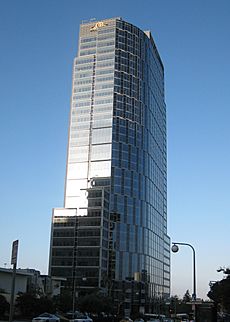
Before 2003, MGM's headquarters were in Santa Monica, California. In 2000, it announced it was moving to a new building in Century City. This building became known as MGM Tower and opened in 2003. The former MGM chairperson, Alex Yemenidjian, made sure the offices were very fancy, with marble pillars and a grand staircase. The building had special features for celebrities, like a private garage and elevator. The street leading to the garage was renamed MGM Drive, and a large, lit-up MGM logo was on top of the building.
After coming out of bankruptcy in 2010, MGM announced it would move its headquarters to Beverly Hills to help reduce its debt. The rent in Beverly Hills was much lower than in MGM Tower. MGM left its namesake tower on August 19, 2011.
Leo Logo and Mottos
MGM's official motto, "Ars Gratia Artis", is a Latin phrase that means "Art for art's sake". Howard Dietz, the studio's chief publicist, chose it. The studio's logo shows a roaring lion surrounded by a film ring with the motto written on it. The logo, featuring Leo the Lion, was created by Dietz in 1916 for Goldwyn Pictures and updated for MGM in 1924. The sound of Leo the Lion's roar was added to films for the first time in August 1928.
In the 1930s and 1940s, the studio also used the slogan "more stars than there are in heaven." This referred to the many famous movie stars who worked for MGM. This motto was also created by Dietz and first used in 1932.
On March 8, 2021, the studio updated its brand. It introduced a realistic computer-generated version of its Leo the Lion logo. It also created a new print logo for TV, digital, and movie posters, using just the company's initials to make it easier to recognize in small sizes.
As of September 2023, this new logo is also used to represent Amazon MGM Studios at the start of films made or distributed by the parent company.
MGM's Film Library
Turner Entertainment Co.
After briefly owning MGM in 1986, Ted Turner created Turner Entertainment Co. This company held the rights to MGM films and TV shows made before May 1986. For several years, MGM continued to distribute home video versions of these films under a license from Turner. However, in 1990, MGM sold all its home video distribution rights to Warner Bros. After Turner's companies were bought by Time Warner Entertainment in 1996, the rights for the Turner-owned films went to Warner Home Video in 1999. Turner Entertainment, now part of Warner Bros. Discovery (WBD), is still listed as the copyright owner.
Film Series
| Title | Release date | No. Films | Notes |
|---|---|---|---|
| Ben-Hur | 1925–2016 | 5 | 1925 film is publicly available; 1959 remake and King of Kings are owned by Turner Entertainment |
| The Broadway Melody | 1929–1940 | 4 | |
| Tarzan | 1932–1942 | 6 | |
| The Thin Man | 1934–1947 | 6 | |
| Andy Hardy | 1937–1958 | 16 | |
| Dr. Kildare | 1938–1942 | 9 | |
| Maisie | 1939–1947 | 10 | |
| Nick Carter | 1939–1940 | 3 | |
| Dr. Gillespie | 1942–1947 | 6 | |
| Lassie | 1943–1949 | 6 | |
| Father of the Bride | 1950–1951 | 2 | |
| The Magnificent Seven | 1960–2016 | Acquired from United Artists | |
| James Bond | 1962–present | 25 | |
| The Pink Panther | 1963–present | 11 | |
| Flipper | 1963–1996 | 3 | |
| Space Odyssey | 1968–1984 | 2 | |
| That's Entertainment! | 1974–1994 | 4 | Co-production with Turner Entertainment Co.; owned by Warner Bros. |
| Rocky | 1976–present | 9 | Acquired from United Artists |
| Fame | 1980–2009 | 2 | Ownership of the original film by Turner Entertainment Co. |
| Poltergeist | 1982–2015 | 3 | |
| The Secret of NIMH | 1982–2009 | 2 | |
| WarGames | 1983–2008 | ||
| Teen Wolf | 1985–2023 | 3 | Acquired from PolyGram Filmed Entertainment; co-production with Paramount Pictures and MTV Entertainment Studios |
| RoboCop | 1987–2014 | 4 | Acquired from Orion Pictures |
| Child's Play | 1988; 2019 | 2 | |
| All Dogs Go to Heaven | 1989–1996 | ||
| Bill & Ted | 1989–2020 | 3 | Acquired from Orion Pictures |
| Hannibal Lecter | 1991–2007 | 2 | Acquired from Orion Pictures; distribution only |
| Species | 1995–2007 | 4 | |
| Carrie | 1976–2013 | Acquired from United Artists; co-production with Screen Gems | |
| Legally Blonde | 2001–present | 5 | |
| Jeepers Creepers | 2001–2003 | 2 | |
| Barbershop | 2002–2016 | 4 | |
| Agent Cody Banks | 2003–2004 | 2 | |
| Hot Tub Time Machine | 2010–2015 | ||
| Spud | 2010–2014 | 3 | |
| The Girl with the Dragon Tattoo | 2011–2018 | 2 | |
| 21 Jump Street | 2012–2014 | Co-production with Columbia Pictures | |
| The Hobbit | 2012–2014 | 3 | Co-production with New Line Cinema; co-owned with Warner Bros. |
| G.I. Joe | 2013–2021 | 2 | Distribution by Paramount Pictures |
| Max | 2015–2017 | ||
| The Addams Family | 2019–present | Co-production with Universal Pictures |
Top-Grossing Films
| Rank | Title | Year | Box office gross | Studio labels |
|---|---|---|---|---|
| 1 | Skyfall | 2012 | $304,360,277 | MGM |
| 2 | The Hobbit: An Unexpected Journey | $303,030,651 | ||
| 3 | The Hobbit: The Desolation of Smaug | 2013 | $258,387,334 | |
| 4 | The Hobbit: The Battle of the Five Armies | 2014 | $255,138,261 | |
| 5 | A Star is Born | 2018 | $215,333,122 | |
| 6 | Gone with the Wind | 1939 | $200,882,193 | |
| 7 | Spectre | 2015 | $200,074,609 | |
| 8 | 22 Jump Street | 2014 | $191,719,337 | |
| 9 | Dances With Wolves | 1990 | $184,208,848 | Orion |
| 10 | Rain Man | 1988 | $172,825,435 | UA |
| 11 | Quantum of Solace | 2008 | $168,368,427 | MGM |
| 12 | Casino Royale | 2006 | $167,445,960 | |
| 13 | Hannibal | 2001 | $165,092,268 | |
| 14 | Die Another Day | 2002 | $160,942,139 | |
| 15 | No Time to Die | 2021 | $160,869,031 | |
| 16 | Creed III | 2023 | $156,248,615 | |
| 17 | Platoon | 1986 | $138,530,565 | Orion |
| 18 | 21 Jump Street | 2012 | $138,447,667 | MGM |
| 19 | The Silence of the Lambs | 1991 | $130,742,922 | Orion |
| 20 | Rocky IV | 1985 | $127,873,716 | UA |
| 21 | The World Is Not Enough | 1999 | $126,943,684 | MGM |
| 22 | Tomorrow Never Dies | 1997 | $125,304,276 | UA |
| 23 | Rocky III | 1982 | $125,049,125 | |
| 24 | G.I. Joe: Retaliation | 2013 | $122,523,060 | MGM |
| 25 | Rocky | 1976 | $117,235,147 | UA |
| Rank | Title | Year | Box office gross | Studio labels |
|---|---|---|---|---|
| 1 | Skyfall | 2012 | $1,108,569,499 | MGM |
| 2 | The Hobbit: An Unexpected Journey | $1,017,106,749 | ||
| 3 | The Hobbit: The Battle of the Five Armies | 2014 | $962,253,946 | |
| 4 | The Hobbit: The Desolation of Smaug | 2013 | $959,079,095 | |
| 5 | Spectre | 2015 | $880,707,597 | |
| 6 | No Time to Die | 2021 | $774,153,007 | |
| 7 | Casino Royale | 2006 | $616,577,552 | |
| 8 | Quantum of Solace | 2008 | $589,593,688 | |
| 9 | A Star is Born | 2018 | $436,433,122 | |
| 10 | Die Another Day | 2002 | $431,971,116 | |
| 11 | Dances With Wolves | 1990 | $424,208,848 | Orion |
| 12 | Gone with the Wind | 1939 | $402,382,193 | MGM |
| 13 | G.I. Joe: Retaliation | 2013 | $375,740,705 | |
| 14 | The World Is Not Enough | 1999 | $361,832,400 | |
| 15 | Rain Man | 1988 | $354,825,435 | UA |
| 16 | GoldenEye | 1995 | $352,194,034 | |
| 17 | Hannibal | 2001 | $351,692,268 | MGM |
| 18 | Tomorrow Never Dies | 1997 | $333,011,068 | UA |
| 19 | 22 Jump Street | 2014 | $331,333,876 | MGM |
| 20 | Rocky IV | 1985 | $300,473,716 | UA |
| 21 | Creed III | 2023 | $276,148,615 | MGM |
| 22 | Tomb Raider | 2018 | $274,950,803 | |
| 23 | The Silence of the Lambs | 1991 | $272,742,922 | Orion |
| 24 | Rocky III | 1982 | $270,000,000 | UA |
| 25 | Hercules | 2014 | $244,819,862 | MGM |
Film Distribution
In the United States, MGM currently distributes its own films and others it buys from other companies through Amazon MGM Studios Distribution. This includes films made by the revived Orion Pictures and American International Pictures, and the 2024 version of United Artists. Before 2023, they were distributed by United Artists Releasing. For international distribution, MGM's films are currently distributed by Sony Pictures Releasing International. Before that, they had a four-year deal with Warner Bros. Pictures, and before that, Universal Pictures.
From 1924 to 1973 (worldwide) and 1981 to 2010 (in the US), MGM mostly distributed its own movies. In October 2017, MGM started distributing films in US theaters again by partnering with Annapurna Pictures.
There were also times when MGM used other companies for distribution. From 1973 to 1981, United Artists distributed MGM's films in North America. In 1981, United Artists' international branch joined with another company to form United International Pictures. MGM worked with that company until 2000, when it made a deal with 20th Century Fox for international distribution. From 2005 to 2016, Sony Pictures Entertainment distributed some MGM films.
MGM also distributed films from other companies like Carolco Pictures (1994–1995) and The Weinstein Company (2006–2008). It also handles some international distribution for Annapurna Pictures' films.
Other International Deals
In 2012, MGM made deals with companies like Forum Film to release its films in countries like Poland, Hungary, and Israel. That same year, MGM arranged for its films to be distributed in Denmark, Sweden, and Norway through AB Svensk Filmindustri (now SF Studios). It also made deals for distribution in Finland and Portugal.
In 2018, for some films, MGM arranged international distribution with various companies around the world. For example, Entertainment One distributed films in Canada, and Vertigo Releasing handled the UK market.
See also
 In Spanish: Metro-Goldwyn-Mayer para niños
In Spanish: Metro-Goldwyn-Mayer para niños
- List of libraries owned by Metro-Goldwyn-Mayer
- List of MGM Television programs



